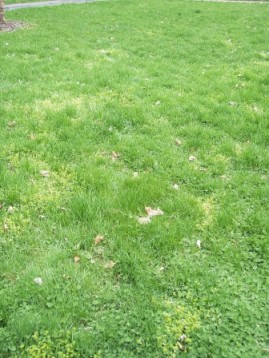
Actually there are a handful — you may be able to make them out toward the top of the photo.
But. There are far fewer than there were last year, which is a reason to celebrate, because this marks the one-year anniversary of my starting a program of organic broadleaf control.
My secret weapon is corn gluten, a byproduct of cornstarch production that acts as a natural pre-emergent herbicide — it inhibits root growth of newly sprouted seeds. (It’s also a 10-0-0 slow release fertilizer.) (I buy it at Bristol’s farm market in Victor.)
In addition to the corn gluten, I set my mower blades pretty high (three inches). The idea is that taller grass is healthier grass — the root system becomes stronger — and healthier grass is able to crowd out other plants. Taller grass also helps the earth retain moisture and prevents light from reaching any weed seeds, which prevents them from germinating. It looks okay, too — when it’s freshly cut it’s nice and neat; you can’t really tell it’s being cut longer unless you walk across it. (Don’t use the photo as the guide on that point — I haven’t mowed yet, this spring.) And it doesn’t mean I have to cut more often, either — leaving it longer doesn’t make it grow faster.
My lawn is a perfect lab for this experiment, since my property’s previous owner never did anything but mow, and until last year, I didn’t either. So that was 15, maybe 20 years of laissez-faire lawn care, plenty of time to establish a nice colony of broadleaf plants: ground ivy, white clover, violets, broad leaf plaintain, speedwell, dandelion, purslane, wild lettuce, dock.
In the photo, you can see clover in the foreground. The lighter-color patches are speedwell, probably slender speedwell, Veronica filiformis. It’s a low-growing plant that tends to spread out in mats. It is more noticeable now than it will be later, because it’s in its first flush of spring growth. Plus the patches are smaller this year than before.
Which means next year they’ll be smaller yet. Or who knows? Gone completely. We”ll see.
What I’m doing, at this point, is waiting out the perennials. Dandelions, for instance, can live five years or so. I have to wait until the established plants have passed on before my lawn will be pretty much dandelion-free.
Speedwell is a nice little plant, actually, with pretty, delicate little flowers. I also like dandelions. But I’m proving a point to anyone in my neighborhood (or elsewhere, for that matter) who thinks they need to hire chemical companies to spray horrible-smelling, toxic, expensive chemicals on their grass.
Corn gluten isn’t outrageously expensive, either. A $30 bag is plenty to treat my front yard. (I don’t bother with the back yard.) I’ve only treated it in the spring although I’ve read somewhere that a second, late summer application is helpful since some weeds germinate in the fall.
You’ll pay more to have an organic lawn care company care for your lawn than a conventional lawn care company, of course.
But if you’re willing to spread the stuff yourself, it’s not a budget-breaker.
Here’s an Organic Gardening magazine article on organic lawn care.
Here’s another, although this one kind of plays up the expense and difficulty. It’s not that complicated, really. I suppose some lawns might be more trouble, if the soil was deficient in specific nutrients or something. But in my case, if I decided to do more, like spread compost, it would be just for the sake of puttering, not because the lawn really seems to need it.
I’ll post another pic after I mow.
Update: and then came the compost …
